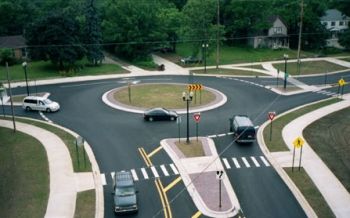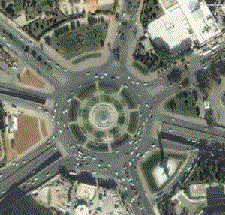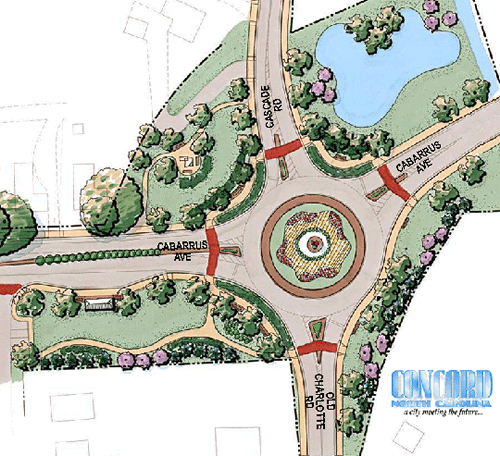
Publisher:
Bonnie King
CONTACT:
Newsroom@Salem-news.com
Advertising:
Adsales@Salem-news.com

~Truth~
~Justice~
~Peace~
TJP
Nov-09-2008 15:45

 TweetFollow @OregonNews
TweetFollow @OregonNews
Are Roundabouts the Answer for Our Traffic Problems?
Tim King Salem-News.comA different kind of revolution for American drivers.
 Courtesy: Yakima, Washington |
(SALEM, Ore.) - I remember the first roundabout in Las Vegas and with it, the frustration and confusion of drivers unaccustomed to this European style traffic pattern.
The roundabouts at Summerlin, a few miles west of the famed "Las Vegas Strip", are in a semi rural part of Sin City; an area where 45 and 50 MPH speed limits meet two-way stops and crashes are grisly and often fatal.
Progressive-minded city planners found an answer in using roundabouts for the upper-end suburb of Las Vegas. Online forums discuss the fact that a lot of Las Vegas locals continue to be less than thrilled, but most seem to realize that the roundabouts save lives.
There are no left hand turn or head-on crashes when traffic slows for roundabouts. Drivers have to work with each other and if a person misses their turn, they can just keep going around until they reach it again.
While Las Vegans have mixed reviews of the Summerlin roundabouts, 50 have been built in Carmel, Indiana since 2001, and that city has seen a 78% decline in injuries related to traffic accidents.
Carmel city officials report that their roundabouts save 24,000 gallons of gas a year.
A recent Kansas State University study shows a 65% average drop in vehicular delays when roundabouts are used.
Those numbers seem hard to argue with. Modern roundabouts have an amazing level of safety and they save taxpayers big bucks.
How Roundabouts Work
I learned how to properly navigate roundabouts while driving in France, and I was amazed that I could get in the inside lane and drive round and round until I was sure of my turn. Roundabouts in the U.S. and France always move to the right, and drivers have to come to at least a near stop before entering them.
 Roundabouts and traffic circles from |
Using a roundabout is like making a "right turn on red". A driver approaches the yield sign, looks for oncoming traffic coming from the left, sees an opportunity in the traffic flow, and then turns right. Once you have entered the roundabout, you don't have to be in a hurry to make your next move.
Inside the roundabout, a driver continues circling counter-clockwise until reaching the desired exit. Exit maneuvers are also right turns. The use of turn signals is important in traffic circles as part of safety and driver etiquette. Drivers who will continue to proceed straight through the roundabout do not signal in most cases, but you should verify that with local law enforcement.
History
The first roundabout was constructed in Paris around the Arc de Triomphe in 1901, according to Wikipedia.
The BBC says the first "recognizable modern roundabout" was New York's Columbus Circle. The first British roundabout came five years later, in Letchworth Garden City in 1909. Interestingly, this was initially intended to serve as a traffic island for pedestrians.
The popularity of roundabouts grew after British engineers re-designed that country's traffic circles in the mid-1960s. Frank Blackmore invented the mini roundabout to overcome its limitations of capacity and for safety issues.
Roundabouts vs. Traffic Circles
Traffic circles are found throughout the U.S., particularly in places like Washington DC, New Jersey, and Pennsylvania. This type of intersection is fading into the past as the new roundabouts evolve as the safest and most efficient design.
Traffic circles can involve stop signs or stop signals. They frequently operate at higher speeds and often require motorists to move from one lane to another.
Unlike traffic circles, roundabouts operate with yield control to give priority to circulating traffic and eliminate much of the driver confusion associated with traffic circles and driver wait associated with junctions that have traffic lights.
Roughly the same size as signaled intersections with the same capacity, roundabouts also are significantly smaller in diameter than traffic circles, separate incoming and outgoing traffic with pedestrian islands and therefore encourage slower and safer speeds.
Modern Approaches
Roundabouts remove illegal options; it is as simple as that. It seems like responsible government leaders might want to take a closer look if they want to save lives and money.
Oregon State Police and other law enforcement agencies devote a lot of time and money to catching drivers who violate speed limits. They even use unmarked cars for traffic enforcement and that opens the door for police impostors who seek to assault lone drivers on our highways.
The state of Washington also uses unmarked cars and pickups for traffic enforcement and it is hard these days to know who is who when a red light appears in your mirror. It seems like a good time for Oregon and Washington as well as the nation's other 48 states to invest in sound practices that eliminate problems and save us all time and money.
 Special thanks to ci.concord.nc.us for the use of this image. |
Modern roundabouts are relatively new to the U.S., but they are common in the United Kingdom and Australia and are becoming very popular in many other European countries.
Having stated that, it is noteworthy that one of the first modern roundabouts was created in New York City. It is one more example of American ingenuity when it comes to modern and efficient designs.
Time Magazine reported in September 2008, that about 1,000 roundabouts have now been built in 25 states. Perhaps more American cities and towns and counties and states will adopt this successful approach more widely in the future.
Special thanks to:
Wikipedia
alaskaroundabouts.com
camrose.com
blogs.lasvegasnow.com
fcgov.com
Image sources:
nashville.gov
beyond.ca
k-state.edu
nelson-construction.com
Reid Middleton, Inc.
seanyboy.co.uk
services-techniques.met.wallonie.be
ci.concord.nc.us
edenprairieweblogs.org
Articles for November 8, 2008 | Articles for November 9, 2008 | Articles for November 10, 2008



Quick Links
DINING
Willamette UniversityGoudy Commons Cafe
Dine on the Queen
Willamette Queen Sternwheeler
MUST SEE SALEM
Oregon Capitol ToursCapitol History Gateway
Willamette River Ride
Willamette Queen Sternwheeler
Historic Home Tours:
Deepwood Museum
The Bush House
Gaiety Hollow Garden
AUCTIONS - APPRAISALS
Auction Masters & AppraisalsCONSTRUCTION SERVICES
Roofing and ContractingSheridan, Ore.
ONLINE SHOPPING
Special Occasion DressesAdvertise with Salem-News
Contact:AdSales@Salem-News.com
googlec507860f6901db00.html

Terms of Service | Privacy Policy
All comments and messages are approved by people and self promotional links or unacceptable comments are denied.
Charles Spasaro October 6, 2010 8:07 am (Pacific time)
I love roundabouts for a hundred reasons. A doubting thomas said roundabouts cost more than traffic lights to install, although maintenance and electricity are less with roundabouts. Anyone know of any documented cost comparisons?
josh kramer hjk April 4, 2010 3:59 pm (Pacific time)
i am so delighted to see this article. i have been a john the baptist preaching this for years. you have addressed all of the issues plaguing our society. road rage is fueled by intersection hang up's. america is going insane with stress from the cross-ways and intersections. the other day i saw an old fellow go right through a stop sign like he didn't see it, on to a busy street. he would have gotten creamed by any one and even me, if i were moments too soon. please use my comments to advise politicians to rethink the expensive brand new intersections being built in rural areas. the cameras are already mounted and the lights are still in the paper wrappers ready to be unleashed on us at cascade hwy exit off of hwy 22. insane! hjk
ScottB November 12, 2008 5:05 pm (Pacific time)
When comparing the cost of a modern roundabout to a traffic signal solution, the best measure is called life-cycle costs. The comparison of all costs over 20 years. This would include easy to measure or predict items like maintenance, electricity and first costs (concrete and right of way), but also costs like vehicle emmissions, delay and crashes. When looking at life-cycle costs, roundabouts usually win.
Joe November 12, 2008 12:54 pm (Pacific time)
I lived and drove in England for three years. Roundabouts were the norm and worked very well. Even on the major "carriageways" traffic flowed well. The major drawback to them is they take alot of space to be constructed properly and it will take extensive public education campaigns of their proper use. Salem has a few traffic circles but it seems they are primarily for slowing traffic.
Corvallis--ite November 11, 2008 12:53 pm (Pacific time)
I agree with j greene. The City of Corvallis modified an existing intersection by putting a big round planter in the middle and you can barely get around it.
j greene November 10, 2008 8:18 am (Pacific time)
i think they are an answer . they MUST be large enough for cars to handle them , too small and aggressive drivers will leave fenders all over . i drove in many they NEED the acreage .if you havent seen or used them , your opinion dont count . LARGE DIA. THEY ARE GREATE
geno November 10, 2008 9:34 pm (Pacific time)
With all due respect to wikipedia, the Arc de Triomph is NOT a roundabout; neither is Columbus circle. They are Traffic circles- NOT roundabouts. The first modern roundabout in the USA was not until 1991. There were not even any in the world until around 1965 in the UK. Traffic circles are NOT roundabouts. France has about 30,000 roundabouts BUT there are none in Paris. Hundreds of circles but no roundabouts.
EazyMoney November 10, 2008 1:19 pm (Pacific time)
I've lived in numerous areas that had traffic circles or roundabouts, they are great for when you have say 5 streets coming into an intersection, or 3-4 that don't make a very good intersection due to the angle of approach. We have at least 4-5 roundabouts in Salem in older sections of town such as in the flats in West Salem, or in the older residentials in North Salem. They are just an antiquated nuisance really in these particular instances. The problem with Salem driving, is we have too many one way streets and an overload of traffic. How roundabouts would solve this is beyond me. Name 3 intersections in Salem that are currently regular traffic signal intersections, that would benefit from being converted into a roundabout, and explain what the benefit would be. Unless the circumstances dictate use of a roundabout, i.e. more than 4 streets converging on an intersection, odd angled intersections, antiquated streets intersecting new construction, I don't see how having them would alleviate traffic congestion or other traffic related issues we see here in the Salem area.
jimmy November 10, 2008 1:08 pm (Pacific time)
Here in the state to the north, we have quite a few and... as long as the traffic is fairly balanced, it works well... if there are two adjacent sides with a lot of traffic, it often backs up on one of the sides requiring some thought durign the planning of these. Once people realize what they need to do, they move pretty smooth.
Glen November 9, 2008 5:54 pm (Pacific time)
I spent a week in Bend at the end of the summer. Roundabouts are common there. The real problem with them in my experience is that you can never be sure of what the other driver is going to do once they enter the circle. Everyone is supposed to signal when they intend to leave, but almost no one does. If you compare the cost of a traffic signal vs. the cost of repaving a circle, I'm not sure which would be better.
[Return to Top]©2025 Salem-News.com. All opinions expressed in this article are those of the author and do not necessarily reflect those of Salem-News.com.